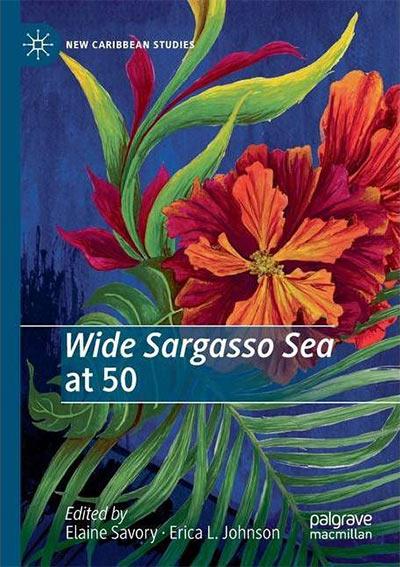

Wide Sargasso Sea At 50
Erica L. Johnson, PhD
Professor, English

What is the central theme of your book?
My coeditor, Elaine Savory (The New School) and I built on two symposia that took place in 2016 to celebrate the fifty-year anniversary of the publication of Caribbean writer Jean Rhys’s important novel. Our book covers most of the presentations from both symposiums, but it turned out to be about much more than a novel because of the incredible reach of Rhys’s cultural influence. We include an interview with award-winning writer Caryl Phillips as well as chapters on how the novel speaks to fashion design, art, theater, the #MeToo movement, and other literary works.
What inspired you to write this book?
This book was inspired above all by collegiality. It grew quite organically from the 2016 symposia in London and New York, where it was inspiring to be in the room with people from the US, the UK, and Australia, whose names I had long known from their work on Rhys. I also loved working with Elaine Savory.
Why is this book important in your field? What does it contribute to the current body of knowledge on its topic?
This book solidifies the importance of Rhys’s Wide Sargasso Sea, a novel that is sometimes read as subsidiary because it is a prequel to Charlotte Brontë’s Jane Eyre. Rhys takes the story of Bertha Mason, the Jamaican woman whom Brontë’s hero (Mr. Rochester) marries and then imprisons in the attic of his English estate, and gives her a voice of her own. Rhys’s story plays out almost entirely in the Caribbean of the nineteenth century and delves into the racial and cultural violence of British colonialism. Our book is the first to note its reception in such a broad range of the arts. It presents Rhys’s novel as a source, not a product, of influence, and it really is spectacular how our contributors spin out everything from the novel’s representations of race and gender to its color palette and soundtrack.
Were students involved in any research related to your book?
Yes, in the sense that I have taught this novel many times at Pace and have learned so much from my students.
Tell us about a particularly special moment in writing this book.
In addition to cowriting the introduction and a chapter, it was my honor to edit the other chapters, which meant that I was able to enjoy exchanging ideas with many different artists and writers. One of my favorite moments leading up to the book was actor Diana Quick’s performance at the London symposium. She did a scene from a play, After Mrs. Rochester, in which she played Rhys. Seeing and hearing Rhys come to life in her uncanny portrayal was really thrilling.
What is the one thing you hope readers take away from your book?
Like many women writers of her generation, Jean Rhys has been subject to some pretty condescending criticism, but she created works of genius (and as much as I admire Wide Sargasso Sea, I actually see Good Morning, Midnight [1939] as her greatest work!). I hope that readers appreciate the depth of her anticolonial vision and artistic accomplishment. Through her re-envisioning of a Victorian novel (Jane Eyre), Rhys models a strategy of decolonizing English literature by pointing out that even when authors engaged only askance (or not at all) with such topics, they were in fact writing against the historical backdrop of the trans-Atlantic slave trade and imperialism. I also hope readers are as bowled over as I am by Alexa Roccanova’s stunning fashion line inspired by the novel!
Is there anything else you would like to share about your book?
One of our contributors, Chrisila Maida, designs book covers; she spontaneously reached out to us while we were assembling the volume with a cover she had done for Wide Sargasso Sea—not because she had been commissioned to do so, but because the novel sparks her imagination. We were able to incorporate an interview with Maida into our book and to use her image as our book cover. She gave us such a gift.
What other books have you had published?
I’ve written a few books including Cultural Memory, Memorials, and Reparative Writing (2018) and Caribbean Ghostwriting (2009). Publications in literary studies are usually single-authored articles or books, but I’ve found that I really love collaborative work and coediting books gives me the chance to engage with a community of writers. To that end, this is my fourth coedited book, along with the two I have done with Patricia Moran, The Female Face of Shame (2013) and Jean Rhys: Twenty-First-Century Approaches (2015), and Memory as Colonial Capital (2017), coedited with Éloïse Brezault.
This book solidifies the importance of Rhys’s Wide Sargasso Sea, a novel that is sometimes read as subsidiary because it is a prequel to Charlotte Brontë’s Jane Eyre.
Fun Facts
When did you join Dyson?
I joined the Department of English in the fall of 2013.
What motivates you as a teacher?
Whether I’m teaching a class on Caribbean writers, the literature of migration, or climate change and the social violence it enacts, my mantra is that literature is a form of art and a means of understanding ourselves, one another, and the world. Working through these issues and ideas with Pace students has been a source of endless motivation and ongoing learning for me.
What are you reading right now?
Trying to put doom scrolling behind me, I’m reading several books at once right now, including James McBride’s The Good Lord Bird, and catching up on contemporary Caribbean literature for both personal and professional reasons. The most riveting read I’ve experienced lately is Rumaan Alam’s National Book Award-nominated Leave the World Behind.